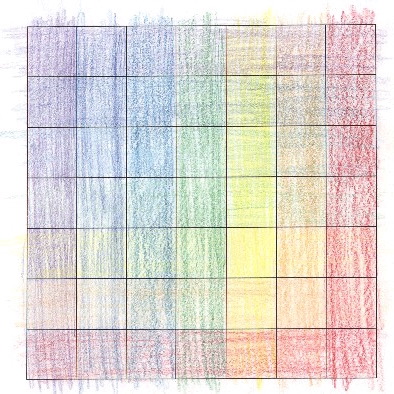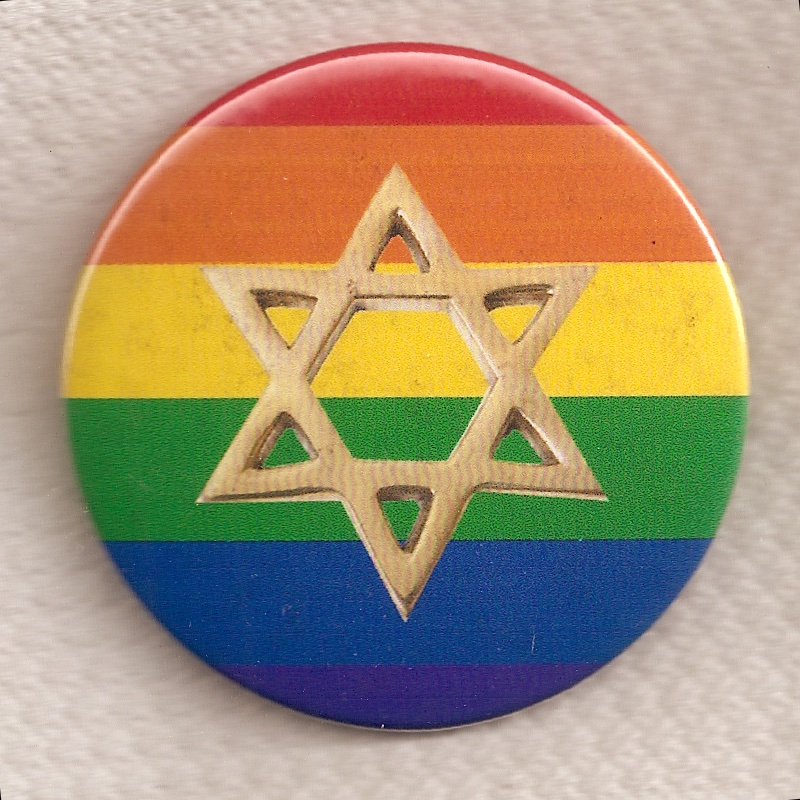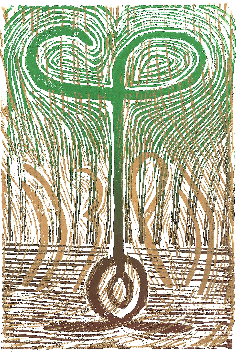Counting the Omer
Imagine a 7×7 grid.
roygbiv
Each row, from right to left, is a different color of the rainbow at 25% concentration: red, orange, yellow, green, blue, indigo and violet.
Each column, from bottom to top, is also a different color of the rainbow at 75% concentration: red, orange, yellow, green, blue, indigo and violet.
That makes the bottom right square 100% red and the top left square 100% violet. A diagonal line of squares of 100% red, orange, yellow, green, blue, and indigo connects them.
Each square represents another in the colors of the spectrum divided into 49 equal parts.
If you begin counting in the lower right corner on the first day of Sefirah, you begin with the “bright red of rebellion” and climb, up each column and to the left each week, ending forty-nine days later at the “brilliant violet of royalty” ready to receive Torah. Each day of Sefirah we focus on that color (and its qualities) as it appears in our world.
I would like to see such an Omer Calendar, but I don’t have the tools. I would also like to see a Web site people could visit each day. Each day of the omer the page would change to display the day’s number and its related color. No more.
If you know someone who has such skills, please let me know.
I shared this idea with a number of friends. Rabbi Amy Scheinerman and her family accepted the challenge.
The more that people worked on the idea, the more possibilities emerged. Rabbi Scheinerman’s father (Andrew Ross z“l, a graphic artist) arranged the squares in a spiral. If you look at it in three-dimensional space we begin at the foot of Sinai and climb up to the summit in time for Shavuot!
Danyel Fisher was a second-year graduate student in the Computer Sciences Department at UC Berkeley at the time this page was originally published back in 2001. He saw my Omer Calendar and accepted the challenge of creating the Javascript version that presents a page of the appropriate color each day. Thank you! However, this has not been available for a number of years. In 2020 I was able to find Danyel and asked if we could restore his Javascript. He responded positively, though indicated that he’d moved on. Nonetheless, he gathered, and shared with me, a few other attempts to count the Omer using color:
- Reclaiming Judaism
- Reconstructing Judaism
- Aleph
- Open Siddur
- Rabbi Jeffrey Goldwasser’s Omer counting
Since 2001, others have developed new Omer Calendars using the medium of the WWW. Brian Rosman invites us to “Count the omer with Homer!” at the “Homer” Calendar. And, there is now a Facebook page for Omer Counters.
Enjoy the count.
© Mark Hurvitz; Originally published 22 March, 2001
Previously updated January 28, 2009 (3 Sh’vat 5769).
After 20 years I have rotated the grid 90º clockwise so that the progression rises from slavery to royalty.
blessing for the rainbow
The Jewish association with the rainbow goes back to the story of Noah. The ancient rabbis even composed a blessing for the event of seeing a rainbow that refers to Noah’s encounter:
.בָּרוּךְ אַתָּה יְיָ׳ אֱלֹהֵינוּ מֶלֶךְ הָעוֹלָם זוֹכֵר הַבְּרִית וְנֶאֱמָן בִּבְרִיתוֹ וְקַיָּם בְּמַאֲמָרוֹ
Blessed are You, Adonai sovereign of all space and time, who remembers the Covenant and is faithful to the covenant and keeps the divine promise [to Noah].
Rabbi David Zaslow writes at his site of the rabbinic tensions regarding the possible metaphors embraced by rainbows.
look to the rainbow
I first encountered Finian’s Rainbow in a Los Angeles city-wide high school production of the musical. Somehow, though my official instrument was the oboe, I was given the part of performing the opening phrase played on a chromonica. I’d never played a chromonica before. Because up to that time it had always been easy for me to create a melody with any other wind instrument I’d picked up, my parents thought the chromonica must be broken. We found someone who could teach me and once I learned the basic technique I was able to fulfill my obligation in the orchestra. I loved the show. The story’s politics are good though some of the lines in the songs are no longer appropriate. Nonetheless, I often sang its songs and quoted some of its lines. This version, from the 1968 Hollywood production is a lovely rendition.
reach over the rainbow

Yip Harburg who co-wrote the book and all the lyrics for Finian’s Rainbow also wrote the lyrics for the 1939 movie The Wizard of Oz. It’s not often that you can see a rainbow from above. In late October of 2016, when Debbie and I visited Niagra Falls we were able to capture this image.
Somewhere…, we look to the rainbow to work for our release from captivity as we struggle to achieve freedom.
making connections with rainbows
Someday we’ll find it, though we’ll probably need to make it… make those connections, make them ourselves: understand how everything, all of us are connected.
rainbow coalitions
The rainbow has taken on multiple meanings since then. Perhaps the most common additional meaning is that as used in the Rainbow Flag as a symbol of LGBTQI pride. Oddly enough, the original Pride flag, created in 1978 by Gilbert Baker in San Francisco had eight bands, not seven. Each color represented a special aspect of life:
- hot pink (sex)
- red (life)
- orange (healing)
- yellow (sunlight)
- green (nature)
- turquoise (art)
- indigo (harmony)
- violet (spirit)
The current flag has only six stripes, eliminating the pink and indigo while changing the turquoise to blue.
When he ran for the Democratic nomination for the presidency in 1984, Jesse Jackson called for a “Rainbow Coalition”:
America is not like a blanket — one piece of unbroken cloth, the same color, the same texture, the same size. America is more like a quilt: many patches, many pieces, many colors, many sizes, all woven and held together by a common thread. The white, the Hispanic, the black, the Arab, the Jew, the woman, the native American, the small farmer, the businessperson, the environmentalist, the peace activist, the young, the old, the lesbian, the gay, and the disabled make up the American quilt.
Needless to say (aside from not mentioning the AAPI community), his hope for this quilt is still in the patch-collecting and stitching stage.
My roygbiv Omer counter uses the colors of the rainbow and is not a representation of the Pride Flag.
Currently 23 buttons in the collection depict or refer to rainbows.
| Date: | 2000s |
| Size: | 5.72 |
| Pin Form: | clasp |
| Print Method: | celluloid |
| Text | [pride flag & magen david] |
your lapel buttons
Many people have lapel buttons. They may be attached to a favorite hat or jacket you no longer wear or poked into a cork-board on your wall. If you have any lying around that you do not feel emotionally attached to, please let me know. I preserve these for the Jewish people. At some point, they will all go to an appropriate museum. You can see all the buttons shared to date.
The image at the top is of a double rainbow captured on March 21, 2006, somewhere in southern France (between Lyon & Avignon).



